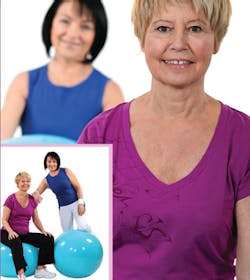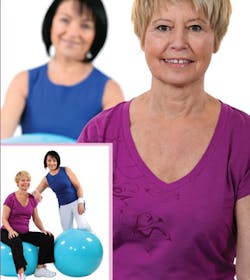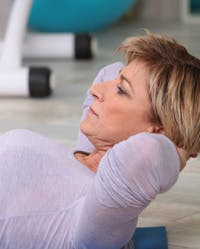Vitamin M: The new nutrient
A little movement can do wonders for health
by SHIRLEY GUTKOWSKI, RDH, BSDH, and JULI KAGAN, RDH, MED
Are you getting all your vitamins? If you believe the news reports, you only have to eat a well-rounded diet to get all your vitamins and minerals. Health is all about the food, right? Even so, we all know people who supplement their diets regardless of food intake; they don't trust the farming system in the U.S.
Then there are many people who believe a multivitamin can bring you up to speed and fill in the nutritional low spots, and some people even supplement their supplements with supplements.
Common knowledge points to inactivity as a major cause of grave and costly health problems. Without exercise we're just as sick as if we're missing vital nutrients from food or supplements. The truth is that exercise is not just about burning calories; exercise is about being healthy. What does exercise really do? The list is so ridiculously long, it's outrageous, but that won't stop us from trying to hit all the benefits. If the word "exercise" is distasteful to you, how about replacing it with "moving?" Are you taking your vitamin M?
Along with good food choices, or in spite of them, movement has its own effect on the body's chemistry. Too much of the wrong types of food or poor eating habits may not be the real issue. Take metabolic syndrome or type II diabetes as good examples of how vitamin M contributes to health. A single session of exercise lowers circulating blood glucose concentrations and reduces hyperglycemic episodes (high blood glucose) in type 2 diabetic patients. Exercise also helps the hypothalamus read the amount of circulating insulin, which supports hunger regulation.
Movement has profound effects on the function of a number of glands and their corresponding impact on a number of the body's systems through the release of hormones.
Consider reading:Exercise of the Month for April 2013
Consider reading:Exercise of the Month for March 2013
Cortisol, the stress hormone, is a slow-acting hormone that decreases the rate of glucose use by cells, and can stimulate fatty acid production from adipose tissue. Of great importance is that systemic cortisol levels decrease during low-intensity exercise.
The scientific bottom line — When you move the body, it more accurately balances blood glucose. That's right -- exercise has hormonal effects beyond the pancreas.
The bottom line of epinephrine and norepinephrine — They regulate the effectiveness of cardiac output. That's important because cardiac output represents the effectiveness of the heart in delivering blood to the rest of the body. Cardiac output measurements help determine how well your blood circulates and contribute to your overall risk measurements for heart failure. You don't get these benefits from bursts of activity such as housework or running to the store, even if you're getting spinach!
According to the U.S. Surgeon General's Report on Physical Activity and Health, inactive people are nearly twice as likely to develop heart disease as those who are more active. Lack of physical activity can also lead to more visits to the doctor, more hospitalizations, and more use of medicines for a variety of illnesses. All of that contributes to the excessive health-care costs that everyone is talking about. Not many people are talking about vitamin M in moderation.
Here's another example of how the body craves vitamin M. Lipoprotein lipase is a molecule that plays a central role in how the body processes fats. Muscles and other body tissues produce lipoprotein lipase. Studies on rats show that leg muscles produce this molecule only when they are actively being flexed, i.e., when the rat is moving.
When you sit, you produce no lipoprotein lipase. A recent meta-analysis (August 2012) found that "sedentary time is associated with an increased risk of diabetes, cardiovascular disease, and cancer, and all of these cause mortality; the strength of the association is most consistent for diabetes."
Sitting is deadly! Believe it or not, science is kicking the butt of the simple act of sitting. Inactivity, or sitting too long, even if exercising during part of the day, can dramatically affect a person's quality of life and how long they live. Low lipoprotein lipase may be the culprit.
Bottom line — Standing during a prophy or a longer appointment, such as a quadrant of root planing, can count toward a daily intake of vitamin M. Make movement nutritious! Your body and your posture will thank you.
No matter your size, being active boosts high-density lipoprotein (HDL) and decreases unhealthy triglycerides. This one-two punch keeps your blood flowing smoothly, decreasing your risk of cardiovascular diseases. In fact, regular physical activity can help you prevent or manage a wide range of health problems and concerns, including stroke, metabolic syndrome, type 2 diabetes, depression, specific types of cancers, arthritis, and falls.
Struggling to fall asleep? Struggling to stay asleep? Regular physical activity can help you fall asleep faster and deepen your sleep.
Leptin is another hormone affected by vitamin M. Leptin is released by adipose tissue, which acts on the hypothalamus, which regulates hunger. Turns out that exercise and sleep affect leptin in two ways.
First, the hypothalamus becomes more sensitive to leptin in people who exercise. The second is described in an interview on WebMD with Dr. Michael Breus, a sleep researcher: "When you don't get enough sleep, it drives down leptin levels, which means you don't feel as satisfied after you eat. Secondly, lack of sleep causes ghrelin levels to rise, which means your appetite is stimulated, so you want more food."
Bottom line — Get good restful sleep. Don't take any vitamins, even vitamin M, too close to bedtime or you may become too energized to fall asleep. FYI: Some possible appropriate bedtime supplements are calcium and melatonin.
The last types of hormones affected by vitamin M are the "mood hormones." The four main neurochemicals that affect mood are serotonin, epinephrine, dopamine, and endorphin. High intensity exercise, or what is called explosive exercise such as tennis, increases epinephrine and decreases dopamine. Lower intensity exercise, such as yoga, Pilates, or biking, increases dopamine. Dopamine and serotonin balance each other and affect sleep and the feeling of well-being. Endorphins contribute to a good mood, and these are raised regardless of the type of exercise. A stressful day can wreak havoc on the balance of these mood hormones, and a little extra vitamin M can reset the works.
That's not all. The hormone story is just part of the need for vitamin M. Exercise also increases the number of natural killer (NK) cells that circulate in the body. Those NK cells target viruses circulating in the body. The effect of increased circulating NK cells can reach to over 400% during intense exercise. Longer than one hour of intense exercise brings that number down to lower than resting numbers, which is presumed to be an effect of the increase in the stress hormone cortisol.
Neutrophils and other white blood cells increase during and after vitamin M. White blood cells actively seek out and destroy all kinds of interlopers that invade the body. In the blood and solid tissue, white blood cells take care of bacteria from planktonic storms released from biofilm. Neutrophils in particular become more active in people who exercise. The casual exerciser may enjoy knowing that intense exercisers don't enjoy the same immune benefits. These elite athletes are more apt to suffer immunosuppression for a time.
Respiratory infections are lower in people who exercise at a light to moderate intensity a few times per week. Less than two hours a day still increases your resistance to upper respiratory infections by about 30%. Intense exercisers are more prone to respiratory infections, which again is blamed on increased cortisol.
Bottom line — Moderate exercise is very effective in stimulating body-healing physiology.
Even cancers can be avoided if you take vitamin M. Breast and colon cancers are particularly affected by regular exercise; risk reduction may be as high as 50%. The American Cancer Society offers a physical activity guideline to reduce cancer risk. They recommend 150 minutes of moderate intensity or 75 minutes of vigorous intensity activity each week (or a combination of these) for adults, and 60 minutes a day of rigorous exercise for children, five days a week.
So far we've learned that just the simple act of moving improves the body's chemistry, bringing up all the health markers and making you want to do more. Since inactivity escalates the chemistry that harms the body, how can you make sure you get your vitamin M if you've never partaken, or it's been a long time? Wilson and Brookfield found 50% of people starting an exercise program drop out within the first six months. These statistics can change, as there is a positive association with a healthy diet and exercise adherence. The more someone exercises and moves, the more likely they are to keep moving.
In the book "The Power of Habit," author Charles Duhigg reports that when people start exercising even as little as once a week, all kinds of other and even unrelated habits transform. Researchers call exercising a keystone habit. To cultivate this keystone habit, the author suggests tracking small wins as an important step. Standing for one patient a day, walking until your breathing becomes labored, or bending over to pick something up off the floor without asking someone else to do it are all small wins that lead to good habit development.
Sequin et al. (2010) observed that the positive health-related outcomes subjects felt from an exercise program were the primary reasons they continued to exercise. Secondly, subjects found that exercise improved their quality of life, and that became a major motivating factor for them to keep exercising. For example, shaving a minute off the time it takes to walk from here to there is one way to "keep moving," and noticing that you can still talk while going up that killer hill is another example of a small win. It's important to get your heart rate up to about 60% of your highest exercise intensity. On a perceived exertion rate scale (see table), you would be moving strongly enough that you could carry on a conversation, but you wouldn't really want to.
The practical bottom line — "Just do it" for at least 30 minutes, four times per week.
Don't fret about it. Mark some time in your calendar and stick with it. Put it down as "me time." Your commitment has to be to your SELF. Make this nonnegotiable. If you're motivated by outside forces, move so you won't be a drain on your children and grandchildren. No one wants assistance with their activities of daily living (ADL) from their grandchildren.
When college students were asked why they exercise, the No. 1 reason by far was because their parents exercised. If you want to increase health, it takes a little discipline to kick off the new habit. But the payoffs are so rewarding! Need some inspiration? Visit JuliKagan.com for free strengthening and stretching videos that are specific for dental professionals.
For those moving for the first time, or for the first time in a long time, some type of paper or mental charting of the small wins can be helpful. Aches and pains mapping can be useful too, as can be noticing how fast aches and pains subside with exercise.
Evidence-based adherence strategies that empower people to exercise for life are imperative. Huberty et al. in 2008 proposed that high self-efficacy is particularly important with women who adhere to exercise. Self-efficacy is a person's confidence in their ability to do exercise(s) with consistency. It's no surprise that a sedentary person may not want to join a marathon team, but may sustain a level of motivation to work with an elastic band a few times a week. Also, self-worth is an important factor for exercise adherence in women.
Bottom line — The more you think you can successfully exercise, the more likely you will adhere to an exercise program.
Pilates and yoga are two exercise regimes that require little equipment and favor adherence and step-by-step progression. They can be performed with others (in a class where accountability matters), with a friend (as a "duet"), or a cappella with a home video. Most importantly, all exercises/poses can be modified to meet the needs of body parts that get in the way. From a spare tire to a stiff shoulder, there are body and prop adjustments for everything that increase the heart rate and temporarily exhaust muscle groups, features of vitamin M that let you know it's working.
Although exercise and physical activity are among the healthiest things a person can do, some older or heavier people are reluctant to get started.
The scientific bottom line — The risks that physical activity will harm you are small and are easily overcome by the benefits. Athletes sustain injuries all the time. Just because you think you're old or heavy doesn't mean you can't sustain an athletic injury. Be an athlete! Sam Horn, intrigue expert and frequent speaker at CAREERfusion discovery retreat, explains that speakers get better engagement if the people they speak to raise their eyebrows over what the speaker says. Imagine the raised eyebrows when you mention your athletic injury, such as stiff muscles.
Other potential exercisers believe that exercising is expensive because gyms, classes, or special equipment are necessary. You can actually start out really inexpensively, but do not scrimp on footwear.
For the most part, older or heavier people lose autonomy because they're not active. Imagine being too weak to get on or off of the commode without assistance. How expensive is your doctor's appointment or those medications? That's why thinking of exercise as a nutrient is so important.
There's an app for that
One of the really cool things available today is the smartphone with apps. There are apps that will help people start whatever type of workout they want, without judgment.
The correct app can help make people accountable to themselves. Or they can put themselves into a group and gain the benefits of working with a group virtually. Most apps are free, so if one doesn't work, delete it and try another. There are apps that track yoga, Pilates, weight training, swimming, biking, aerobics, circuit training, elliptical, and just about any other type of vitamin M. Some apps read your heart rate using the camera on the phone.
Start thinking about exercising as being equally as important as a nutritious diet. Start small and notice subtle changes. Any little measurement of a positive change is awesome. If none of the talk about hormones and immunity does it for you, read this: According to a June 2012 study, people who exercise increase their incomes by 9%. What are you waiting for? Take your vitamin M and keep moving!
SHIRLEY GUTKOWSKI, RDH, BSDH, FACE, is a clinical dental hygienist. Her experience and free thinking have made her a popular international speaker and award-winning author. She is the author of many books, chapters, and articles to support dental hygienists, and she is a career coach at CareerFusion. Her books can be purchased through www.rdhpurpleguide.com. Information on CareerFusion is at www.Careerfusion.net.
JULI KAGAN, RDH, MEd, walks her talk, teaching Pilates and yoga every day, as well as online education courses for Nova SE University. A nutritarian who is passionate about posture as well as physical and mental fitness, Juli wrote "Mind Your Body" and speaks about ergonomics, nutritarianism and peak performance. Visit her website at JuliKagan.com for free exercise videos, her book and information about speaking engagements for your local society, state association, or private practice.
Past RDH Issues



